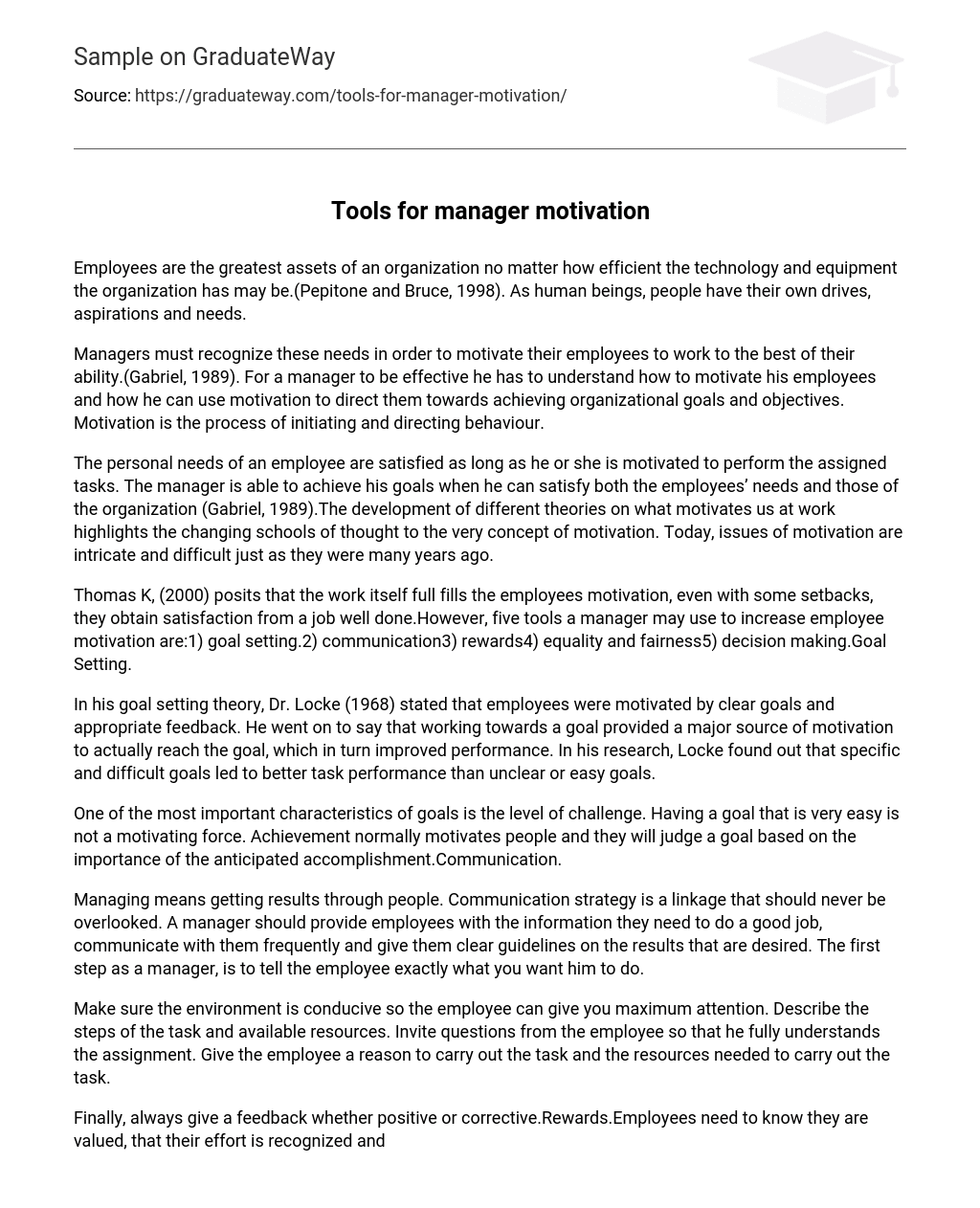Employees are the greatest assets of an organization no matter how efficient the technology and equipment the organization has may be.(Pepitone and Bruce, 1998). As human beings, people have their own drives, aspirations and needs.
Managers must recognize these needs in order to motivate their employees to work to the best of their ability.(Gabriel, 1989). For a manager to be effective he has to understand how to motivate his employees and how he can use motivation to direct them towards achieving organizational goals and objectives. Motivation is the process of initiating and directing behaviour.
The personal needs of an employee are satisfied as long as he or she is motivated to perform the assigned tasks. The manager is able to achieve his goals when he can satisfy both the employees’ needs and those of the organization (Gabriel, 1989).The development of different theories on what motivates us at work highlights the changing schools of thought to the very concept of motivation. Today, issues of motivation are intricate and difficult just as they were many years ago.
Thomas K, (2000) posits that the work itself full fills the employees motivation, even with some setbacks, they obtain satisfaction from a job well done.However, five tools a manager may use to increase employee motivation are:1) goal setting.2) communication3) rewards4) equality and fairness5) decision making.Goal Setting.
In his goal setting theory, Dr. Locke (1968) stated that employees were motivated by clear goals and appropriate feedback. He went on to say that working towards a goal provided a major source of motivation to actually reach the goal, which in turn improved performance. In his research, Locke found out that specific and difficult goals led to better task performance than unclear or easy goals.
One of the most important characteristics of goals is the level of challenge. Having a goal that is very easy is not a motivating force. Achievement normally motivates people and they will judge a goal based on the importance of the anticipated accomplishment.Communication.
Managing means getting results through people. Communication strategy is a linkage that should never be overlooked. A manager should provide employees with the information they need to do a good job, communicate with them frequently and give them clear guidelines on the results that are desired. The first step as a manager, is to tell the employee exactly what you want him to do.
Make sure the environment is conducive so the employee can give you maximum attention. Describe the steps of the task and available resources. Invite questions from the employee so that he fully understands the assignment. Give the employee a reason to carry out the task and the resources needed to carry out the task.
Finally, always give a feedback whether positive or corrective.Rewards.Employees need to know they are valued, that their effort is recognized and their input appreciated. This is done by rewarding them.
In rewarding the employee, the manager should make sure the reward is timely,authentic and matches the aspirations of the employee whenever possible. Taking time out to personally thank an employee for doing a good job is a simple but effective form of reward. Offering an employee the chance to teach others is a big morale booster. Other employees will acknowledge his contribution to work.
Extra pay should be given to employees that meet specific targets.(Performance related pay.) Fringe benefits,(perks) are rewards that an employee receives in addition to his normal salary. This is a huge motivator and also encourages loyalty.
Equality and Fairness.Adams’ theory states that employees strive for equity between themselves and other workers. Equity is achieved when the ratio of employee outcomes over inputs is equal to other employee outcomes over inputs. (Adams, 1965).
Equity theory places value on fair treatment which is believed to be a major motivational factor among employees. When an employee feels that another worker is putting is the same effort but gaining more recognition and compensation he will feel bad and thus perform at a lower level. An employee who feels he more appreciated may feel he is better than others and this may lead to reduced effort on his part.Decision Making.
Participative management is a method of employee motivating which includes employees in decision making in an organization. Allowing employees take part in solving problems, designing and implementing changes,setting goals and making decisions in an organization makes them more dedicated to their jobs. This creates a greater sense of belonging and makes them work as part of a team. Many employees are creative but hardly go to managers to discuss their ideas.
When the power to create is given to employees, those who know the job well from experience are given the opportunity to make input that will benefit the organization. It motivates the employee and the organization develops a more flexible work force.However you look at it, motivating employees appears to be the most complex job a manager has.;;;;;;Bibliography.
Adams, J.S, 1965. Inequity in social exchange. In L.
Berkowitz (ed.). Advances in experimental social psychology. New York Academic Press.
Gabriel, v. 1989. Management. Longman Singapore Publishers (Pte) Limited, Singapore.
Pepitone, J. S, Bruce, A. 1998. Motivating Employees.
McGraw-Hill Professional, U.S.A.Thomas, K.
2000. Intrinsic motivation at work building energy and commitment. Berret-Koehler Publishers, San Francisco.





